- Quick Read
- Deep Read ( 4 Min. )
Monitor Daily Podcast
- Follow us:
- Apple Podcasts
- Spotify
- RSS Feed
- Download
TODAY’S INTRO
Lessons from a stolen catalytic converter
It was, by far, the loudest noise I’d ever heard come out of my 2008 Toyota Prius. So loud, I immediately pulled back into the driveway and called the dealership. “Your catalytic converter has been stolen,” they said.
Thus was launched a two-week odyssey involving insurance, police, repair shop, going carless, and a lot of research. The catalytic converter, I quickly learned, is the antipollution device on an exhaust system. And it contains precious metals – platinum, palladium, and rhodium – the value of which has soared in recent years. As a result, thefts are way up nationwide, and not just in cities.
Thieves can make good money stealing “cats” and selling them to scrap dealers. “They use a battery-powered saw,” Tommy the insurance adjuster said. “It takes 30 seconds.” And, it turns out, my vintage of Prius is targeted, as this article explains.
The repair isn’t cheap and using my insurance would delay the process. Realistically, I’d be without my car for two weeks. That led to the next decision: whether to rent a car. I hesitated ... I love to drive. But it was an easy call. I live in Washington, D.C., and can get anywhere by foot, bus, Metro, Lyft, or hitching rides. Just no trips to Costco.
The two weeks flew by. I missed my baby, but I got back into the habit of using public transportation, after a two-year pandemic break. And combining my daily walk with grocery shopping was marvelously efficient. When my car was ready, I even waited a day to pick it up.
Now it’s home, parked out front under a street lamp. A special shield covers the new catalytic converter. Of course, I could put the Prius in my garage, but, well, that’s full of stuff. One thing at a time.
Share this article
Link copied.

Help fund Monitor journalism for $11/ month
Already a subscriber? Login

Monitor journalism changes lives because we open that too-small box that most people think they live in. We believe news can and should expand a sense of identity and possibility beyond narrow conventional expectations.
Our work isn't possible without your support.
Patterns
Global compassion awakened for Ukraine
Widespread international sympathy for Ukrainians has sparked a sudden and heartfelt campaign to help them, bucking a trend toward nationalism and culture wars.

There is a Yiddish phrase, pintele yid, expressing the belief that however far a Jew has strayed from his faith, there is a tiny flicker of Jewishness inside, waiting to burst into flame. It’s a bit like a pilot light in a gas heater.
Now, the violence in Ukraine seems to have revealed a pilot light in millions of people of all faiths worldwide. A pintele of simple human connection, compassion, and caring has sparked a widespread desire to relieve Ukrainians’ suffering.
We’ve seen such outpourings of concern before, in response to other natural and man-made tragedies. But this seems different.
Partly that’s because it bucks a global trend toward narrow nationalism and culture wars. And also because the international breadth of the popular concern, and of efforts to help Ukrainian refugees, have been remarkable.
Social media, meanwhile, are – for once – bringing people together rather than pulling them apart into opposing political silos.
Smartphones and social media technology have spread real-life images of Russia’s attacks on civilian areas almost instantly, giving the victims’ plight a worldwide 24/7 immediacy seen in no previous war.
The only way to ignore it is to shut one’s eyes. And few people seem ready or willing to look away and do nothing.
Global compassion awakened for Ukraine
It is a phrase I heard many years ago – from an Orthodox rabbi with a long, graying beard and a twinkle of optimism in his eyes – and it’s been increasingly on my mind amid the Russian army’s murderous assault on besieged civilians in Ukraine.
Pintele yid. The words are Yiddish. And, as the rabbi explained, they encapsulate the traditional belief that inside any Jewish person, however distant or alienated from his faith, there’s always a tiny flicker of Jewishness waiting to be rekindled at the most unexpected moment.
It’s a bit like a pilot light in a gas heater that ignites a flame.
Now, the violence in Ukraine seems to have revealed a pilot light in millions of people of all faiths worldwide. A pintele of simple human connection, compassion, and caring has sparked a widespread desire to relieve Ukrainians’ suffering.
The outpouring of concern is not, in itself, new. We’ve seen it in response to a range of natural and man-made tragedies in the past – tsunamis, earthquakes, famines and, yes, wars as well.
But this international wave of solicitude seems different in important ways, not least because of its context. Our young millennium has so far been marked by a trend toward narrow nationalism, culture wars, and a certain disdain for humanitarian concerns as mere “virtue-signaling” or “wokeness.”

The breadth of the popular response has been remarkable. I’m not alone, I suspect, in having been struck by the number of friends who have previously shown little involvement, or even interest, in world affairs but who’ve now become personally invested in what’s going on in Ukraine. And they want to help however they can.
In Britain – an island nation where a growing suspicion of immigrants helped decide the 2016 Brexit referendum vote to leave the European Union – the response has been dramatic. Even MPs from Prime Minister Boris Johnson’s governing Conservative Party have been vocal in urging a much more generous and less bureaucratic policy toward Ukrainian refugees.
When the government opened a website to match potential arrivals with British families willing to give them a home, it was inundated with offers: more than 100,000 on the first day alone.
The response has been even more extraordinary in the poorer countries of Eastern Europe – Poland, Hungary, Romania, Moldova – where more than 3 million frightened women, children, and elderly have already fled.
Poland reacted with alarm seven years ago to Europe’s last refugee influx, from the war in Syria. This time its government is facilitating the arrival of those fleeing the war next door, helped by hundreds of thousands of ordinary Polish citizens who are caring for the refugees at the border and welcoming them into their homes.
There are other significant differences between the Ukraine invasion and crises past. One is technological, as social media sites at last show signs of fulfilling early hopes that they might bring people closer together.
In recent years they have had the opposite effect, cushioning users inside political silos, their walls reinforced by politically skewed news feeds.

Yet from the first days of the Ukraine invasion, smartphones and social media technology have spread real-life images of Russia’s attacks on civilian areas almost instantly, giving the victims’ plight a worldwide 24/7 immediacy seen in no previous war.
The result: The only way to ignore it is to shut one’s eyes. And few people seem ready or willing to look away and do nothing.
The West’s unity in imposing unprecedentedly tough economic sanctions on Russia was largely the fruit of its political leadership, of course. But, in European countries at least, it was ordinary citizens who led the way and set the terms of debate, by demonstrating in their hundreds of thousands against Vladimir Putin’s attack and in solidarity with Ukraine.
Not just in Europe, but in America and beyond, Ukrainian churches have also suddenly found themselves welcoming visitors of all faiths to offer their prayers and support.
And for some, technology has shaped their ongoing response to the suffering.
The home-rental site Airbnb has been swamped by users who have been using the site to make donations to ordinary Ukrainians by signing up to “rent” homes in war zones that they have no intention of actually visiting.
A pair of young Harvard undergraduates, meanwhile, has rushed to set up an Airbnb-like site of their own – called Ukraine Take Shelter – to allow people to link up with Ukrainian refugees forced out by the invasion who are seeking a new home.
My rabbi friend, no doubt, would say that all of this has been as unsurprising as it is inspiring: a case of the divine pilot light igniting a widening flame of humanity.
And I have a feeling that – with the violence in Ukraine nowhere near over, and enormous help still certain to be needed even when it is – he would add a further challenge, and a further hope: that the world can keep that light burning.
Editor’s note: The description of the Ukraine Take Shelter app has been clarified.

The Explainer
Ginni Thomas texts: Three questions
The Supreme Court is not bound by a judicial code of ethics. What happens when a spouse’s actions create questions about impartiality in a case?

- Quick Read
- Deep Read ( 4 Min. )
In the tense weeks following the 2020 presidential election, longtime conservative activist Virginia Thomas, wife of Supreme Court Justice Clarence Thomas, peppered White House chief of staff Mark Meadows with messages urging him to keep fighting to overturn Joe Biden’s victory.
Some of the messages, first reported by The Washington Post and CBS News, referenced fringe conspiracy theories and false charges of fraud as Ms. Thomas railed at what she called “the greatest Heist of our History.”
None of the messages directly referred to her husband. But some legal experts say they raise questions of whether Justice Thomas should recuse himself from any cases dealing with the 2020 election or its aftermath.
Justice Thomas has already ruled in one similar case. Earlier this year he was the lone dissenting vote in an 8-1 ruling that refused a request from former President Donald Trump to block the release of White House records about the Jan. 6 insurrection.
Supreme Court justices are not bound by the judicial code of conduct, which applies to all other federal judges, and requires recusal in any situation in which a fair-minded person might doubt a judge’s impartiality.
Ginni Thomas texts: Three questions
In the tense weeks following the 2020 presidential election, longtime conservative activist Virginia Thomas, who goes by Ginni and is the wife of Supreme Court Justice Clarence Thomas, peppered White House chief of staff Mark Meadows with messages urging him to keep fighting to overturn Joe Biden’s victory.
Some of the messages, first reported by The Washington Post and CBS News, referenced fringe conspiracy theories and false charges of fraud as Ms. Thomas railed at what she called “the greatest Heist of our History.”
In one message to Mr. Meadows shortly after the vote, Ms. Thomas quoted language then circulating on far-right websites that the “Biden crime family” and “ballot fraud co-conspirators,” including “fake stream media reporters,” were already being arrested and would be kept on barges off the military prison at Guantánamo Bay to face military tribunals for sedition.
“I hope this is true,” Ms. Thomas told the White House chief of staff.
In another message, Ms. Thomas referred to a false belief of QAnon conspiracists that President Donald Trump had watermarked mail-in ballots to track and expose voter fraud.
“Watermarked ballots ... have been part of a huge Trump & military white hat sting operation in 12 key battleground states,” she wrote.
None of the messages directly referred to her husband. But some legal experts say they raise questions of whether Justice Thomas should recuse himself from any cases dealing with the 2020 election or its aftermath.
Three questions about these communications:
Where did they come from?
The 29 texts obtained by Bob Woodward of the Post and Robert Costa of CBS News are a fraction of the 2,320 messages provided by Mr. Meadows to the House committee investigating the Jan. 6 attack on the Capitol.
Twenty-one of them were sent by Ms. Thomas to the White House chief of staff, and eight were his replies. They were written between Nov. 4 and 24, with the exception of one sent on Jan. 10, following the insurrection by Trump protesters at the Capitol.
The final missive expressed anger at Vice President Mike Pence for refusing Mr. Trump’s request to block congressional certification of Mr. Biden’s victory. (Mr. Pence – and many legal experts – believed he had no constitutional authority to take such an action.)
“We are living through what feels like the end of America,” Ms. Thomas wrote. “Most of us are disgusted with the VP and are in listening mode to see where to fight with our teams.”
Mr. Meadows is no longer cooperating with the committee, and has filed suit to determine the validity of assertions of executive privilege to block further access to his Jan. 6 records.
Do they matter?
Democrats say the Thomas pipeline reveals her easy access to the highest levels of the American government at a time when Mr. Trump and his allies were hoping to get the election outcome overturned by Supreme Court justices, including her husband.
They also reveal that Ms. Thomas, a longtime, vocal, right-wing presence in Washington, had fully embraced Mr. Trump’s election falsehoods, to the point of repeating fantastical conspiracy theories. She repeatedly urged the White House to embrace Sidney Powell, the lawyer whose so-called Kraken suits alleging voter fraud were all turned back by the courts, and who has been formally sanctioned by a Michigan federal judge for “abuse of the judicial process” by filing baseless lawsuits.
“Sidney Powell & improved coordination now will help the cavalry come and Fraud exposed and America saved,” wrote Ms. Thomas on Nov. 13, in a text she said had also been shared with “Jared,” presumably Jared Kushner, Mr. Trump’s son-in-law.
No solid evidence has emerged of any widespread fraud in the 2020 election. Trump lawsuits alleging the contrary were dismissed at state and federal levels. Officials of both parties from across the nation attested the vote was free and fair, and Trump Attorney General William Barr found no evidence of widespread fraud.
That said, the communication between Mr. Meadows and Ms. Thomas might come as no surprise, given the documented access she and her husband have had to Washington’s conservative circles of power. And it may be notable that the communication largely ran one way, with Mr. Meadows replying only intermittently.
“Nothing about the text messages presents any legal issues,” George Terwilliger III, Mr. Meadows’ lawyer, told the Post.
Should Justice Thomas recuse himself?
Some legal analysts say the publication of the messages shows that Justice Thomas should now recuse himself from any cases that deal with the efforts of Mr. Trump and his allies to overturn election results – or with the effort of congressional investigators to understand those efforts.
There’s one such case now looming on the judicial horizon: John Eastman, a conservative law professor who drew up memos for the Trump team on possible ways to block Mr. Biden’s victory, has filed a suit arguing that attorney-client privilege shields his records from the House Jan. 6 committee. The case could well reach the Supreme Court on appeal.
Justice Thomas has already ruled in one similar case. Earlier this year he was the lone dissenting vote in an 8-1 ruling that refused a request from Mr. Trump to block the release of White House records about the Jan. 6 insurrection.
Supreme Court justices are not bound by the judicial code of conduct, which applies to all other federal judges, and requires recusal in any situation in which a fair-minded person might doubt a judge’s impartiality.
But they are subject to a federal law that among other things requires recusal if their impartiality “might reasonably be questioned,” noted University of Texas Law School professor Steve Vladeck on Twitter.
“The problem, of course, is the absence of an enforcement mechanism,” tweeted Professor Vladeck. That reinforces the need for the Supreme Court to be subject to a more meaningful and enforceable set of ethics rules, he said.
At a GOP retreat in Florida on Friday, House Minority Leader Kevin McCarthy said he didn’t think recusal was necessary in this case. Justice Thomas should make that call, he said.
“It’s his decision based upon law,” said Representative McCarthy.

A deeper look
Is Texas Hill Country being ‘loved to death’?
The Hill Country of Texas is the fastest-growing area of this fast-growing state. But questions about how to manage that growth, from water supply to school commutes, are rising.

- Quick Read
- Deep Read ( 10 Min. )
In rapidly growing Texas, a rustic area west of Austin and San Antonio leads the way in the pace of population gains. Development is inevitable, but not inherently bad, locals here in the Hill Country say.
It needs careful management, they add, but that isn’t something Texas has typically prioritized. The clock is ticking to safeguard what has made the Hill Country so attractive to newcomers.
Locals worry about traffic, affordability, and the loss of small-town character. Eighteen-wheelers roll over narrow country roads, and new housing developments dot the limestone hills. Home values are climbing as low-wage workers struggle for housing.
And of all the development-related issues here, water might be the most challenging. Sewage systems are hitting capacity, and drinking water supplies may not last through the next drought. More people in the Hill Country means not just more demand for drinking water but also more sewage and more pavement – putting fragile aquifers at risk of contamination.
“Everybody is, you know, loving it to death almost,” says David Baker, executive director of the Wimberley Valley Watershed Association. “That’s the challenge: how to balance growth with conservation.”
Is Texas Hill Country being ‘loved to death’?

Deep in the heart of Texas, the traffic is backed up for almost a mile.
It’s a jarring sight for long-time residents of the Hill Country, a rural oasis of scrubby green hills, crystalline water, and bright white limestone west of Austin and San Antonio. But it’s not the only sign that change is afoot in this once rustic and hardscrabble region of the Lone Star State.
Eighteen-wheelers roll over the narrow country roads, and housing developments dot the limestone hills. Home values are climbing as low-wage workers struggle for housing. Meanwhile, sewage systems are hitting capacity, and drinking water supplies may not last through the next long drought.
In one of the fastest growing states in the country, this is the fastest growing region. The population has grown by nearly 50% in the past two decades, according to the Texas Hill Country Conservation Network (THCCN), with much of those gains in unincorporated – and largely unregulated – areas.
There have been positives. A larger tax base is funding high-quality schools; small businesses, particularly in tourism and hospitality, are flourishing. Development is inevitable, and not inherently bad, locals say, it just needs to be planned carefully.
But careful, regulated growth isn’t something Texas has typically prioritized. And with growth and development here only expected to continue in coming decades, the clock is ticking to lock in safeguards for what has made the Hill Country so attractive to newcomers.
“Everybody is, you know, loving it to death almost,” says David Baker, executive director of the Wimberley Valley Watershed Association.
“That’s the challenge: how to balance growth with conservation,” he adds. “How do we make sure that we don’t destroy the thing that attracted us here in the first place?”
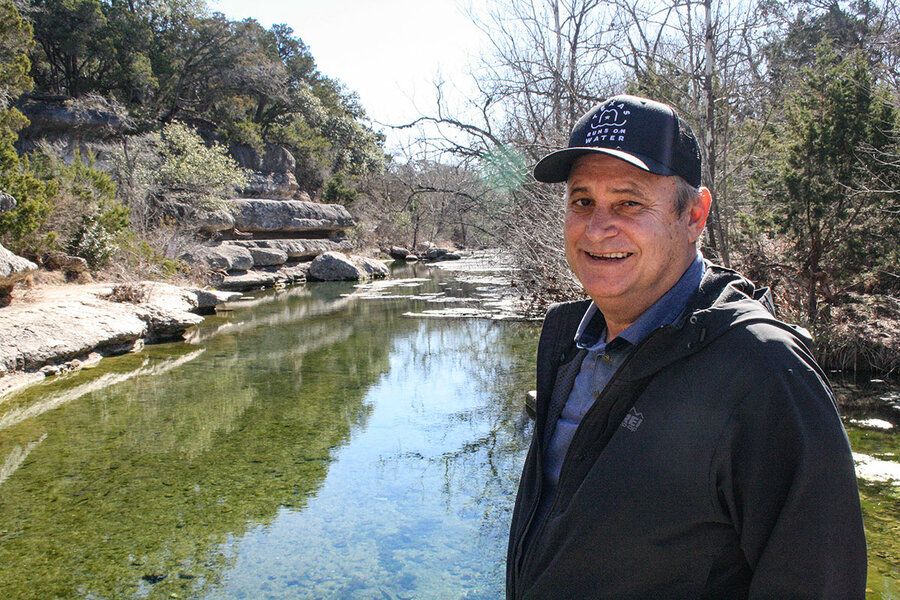
Rapid growth – especially beyond the city limits
There was a time when Dripping Springs – known as “the Gateway to the Hill Country” – didn’t have a single traffic light. Today it has five, and a bona fide rush hour.
The sign at the city limits informs visitors of the population just shy of 1,800, but the sign has been out of date for over a decade. The population has more than doubled since then, and 10 times that number live outside the city limits in its so-called “extraterritorial jurisdiction” or ETJ.
“In the last five years the traffic has been out of control,” says Bill Foulds, the Dripping Springs mayor.
Like most Hill Country towns, recent population growth has not been in Dripping Springs itself, but in its ETJ and unincorporated areas of the county. Residents there don’t pay city taxes, but many do use city roads, sewer systems, and other infrastructure.
Dripping Springs’ population still isn’t big enough to justify a police or fire department. Mayor Foulds desperately wants to improve the city’s central intersection, but there’s only so much they can afford.
In the counties directly west of Austin and San Antonio, the population in unincorporated areas has more than doubled in the past 30 years, according to a recent report from THCCN, a coalition focused on preserving the region’s culture and natural resources. In addition to city infrastructure, those residents also benefit from access to local schools.
“We take it to heart that we cause some of the traffic problems here,” says Thomas Price, superintendent of the Boerne Independent School District.
Indeed, weekday mornings and midafternoons in the city herald a choke of cars dropping off and picking up students. Over 10,000 children attend the district’s 12 schools, and 400 have joined this year alone.
Enrollment is expected to double in the next 10 years, and the district wants to get ahead of the inevitable traffic challenge.
One example: They’re hoping to put an elementary school in a new subdivision, near two other subdivisions, so more kids are walking, biking, or riding buses.
Dr. Price grew up in Houston, watching the city sprawl out 30 miles in every direction with little forethought. He doesn’t want Boerne to end up in that situation, he says, “trying to figure it out afterwards.”
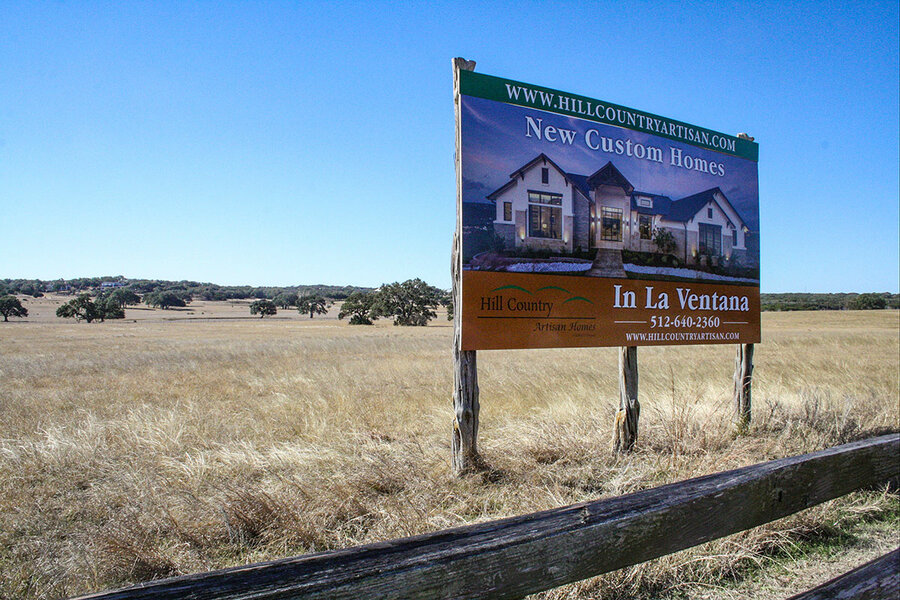
A “miracle,” but is it affordable?
If “the Texas Miracle” could be captured in one image, it might be the main street of a town like Dripping Springs or Boerne.
While cars pack the streets, people crowd the sidewalks. Antique shops, boutique clothing stores, and small restaurants stand next to chain stores like Walgreens, Home Depot, and H-E-B grocery stores.
A combination of low taxes and business-friendly policies have fueled this “miracle” of growth and prosperity, state leaders say, and helped Texas weather the Great Recession and the pandemic better than most states, economically. (When it comes to the COVID-19 death rate, Texas ranks roughly in the middle.)
The degree to which that is true – and not just the result of, for example, a thriving oil industry – has been debated for years. But in the Hill Country, while the economic benefits of growth have been welcomed, some market forces have been raising concerns.
The Hill Country region saw an unprecedented volume of land sales, and increases in land prices, beginning in the second half of 2020, reported the Texas Real Estate Center at Texas A&M University. And as land values have surged, so have home prices and rent.
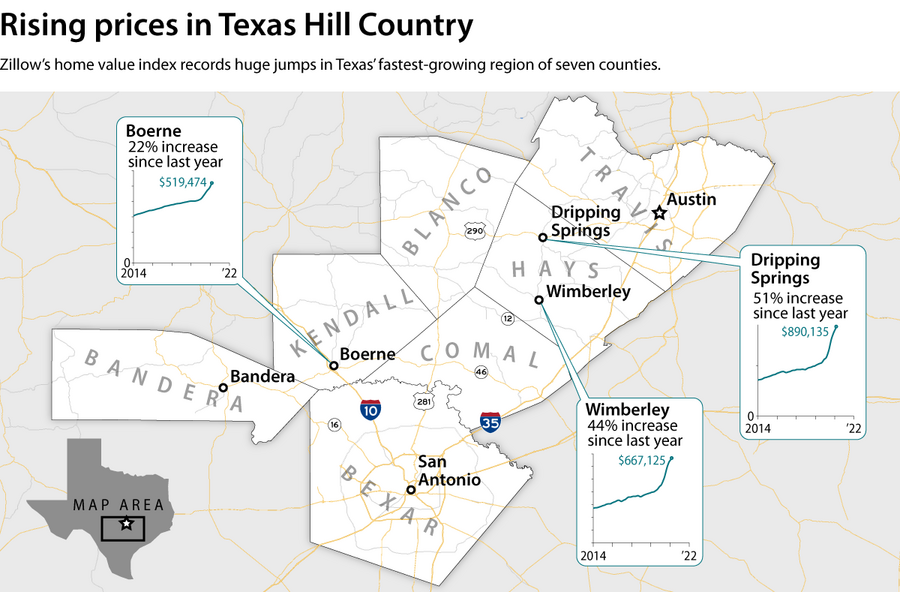
Zillow
In Boerne, Ty Wolosin has seen it firsthand. Both a city council member and owner of a brewpub in the heart of the town’s Main Street, he has staff making $17 an hour. “It’s still hard [for them] to afford to live in Boerne,” he says.
Meanwhile, the school district is struggling to hire hourly-wage workers like custodians and bus drivers, most of whom have to commute from more affordable San Antonio suburbs. At one of the high schools, just five of 14 custodial positions are filled, says Dr. Price.
“There’s not a lot of affordable housing,” he adds. “If we want to be a viable community ... that’s got to be a focus.”
Growth itself could be an answer to affordability issues, some argue.
“It will attract more services and things that will keep our economy diversified and attract opportunity for everyone,” says Jason Giulietti, president of the Greater San Marcos Partnership, a nonprofit that works with a variety of stakeholders – from business leaders to environmental groups – in Hays and Caldwell counties to attract suitable businesses to the region.
“Growth is going to happen,” he says. “We think by being involved and active in it, it lets you control that narrative a bit more.”
Keeping local character alive
In a region where locals used to drive to Austin or San Antonio to buy groceries, development has brought more convenience, but also more homogeneity.
“We’re seeing a sort of encroachment on local community character, local economies,” says Cliff Kaplan, program director at the Hill Country Alliance. “Most towns would like to see that look and feel maintained throughout their new development.”
Bandera has been particularly focused on this. Thirty minutes west of Boerne, the town known as “the Cowboy Capital of the World” has not yet seen the growth of some Hill Country cities.
There isn’t an H-E-B, and the largest store is the Tractor Supply Co. on the edge of town. Downtown, one- or two-story shops line the street with awnings covering the narrow sidewalks. Hitching rails for horses are still found, and used, outside businesses. As a whole, the town’s layout is virtually unchanged from the 1800s.
Rebeca Gibson, a city council member, is hoping it will stay that way regardless of the development she knows will arrive in the coming decades.
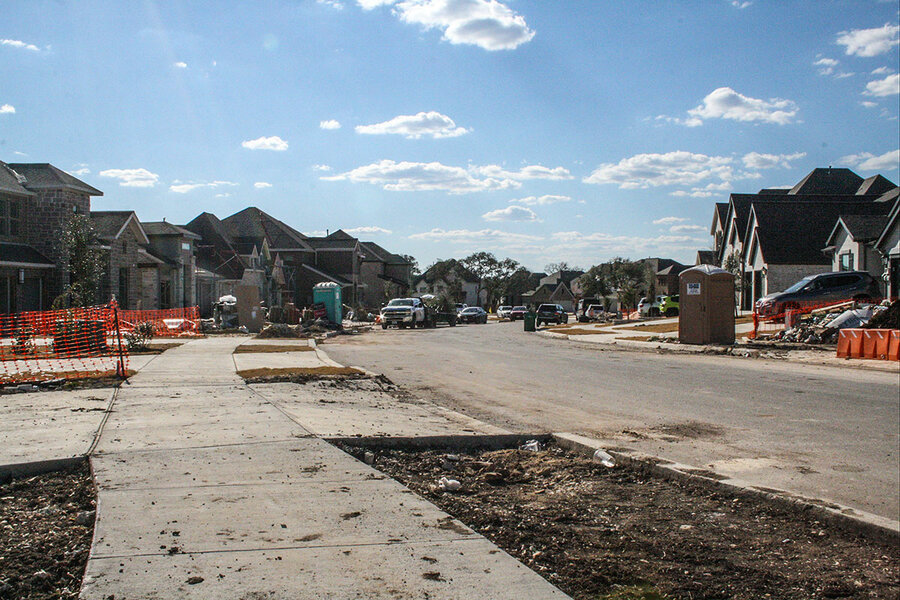
An effort by the city council to revamp local zoning codes is “very, very technical,” says Ms. Gibson. But “it’s a great example of how our city is working towards achieving more responsible development.”
A fragile water supply, under strain
Bandera is now hoping to get ahead of the next big challenge: water.
The town can look like a sepia-toned photograph of the old West, but there’s nothing nostalgic about the liquid waste known as effluent – from the local wastewater treatment plant and sometimes from surface runoff – draining daily into the Medina River that flows through town.
A new wastewater treatment plant is in the works (further from the river), along with some other potential disposal methods.
“I’m just grateful that we have the opportunity to change it,” says Ms. Gibson.
Indeed, of all the development-related issues here, water might be the most challenging – and one where many cities, unlike Bandera, are playing catch-up.
First, there isn’t much of it. The primary source of drinking water has long been a network of underground aquifers flowing through the karst limestone under the hills and feeding a thousand miles of pristine streams. And these aquifers are among the most stressed in the state.
Second, the water that is there is exceptionally clean, and exceptionally easy to contaminate. Karst is the geological equivalent of Swiss cheese, full of holes that allow rainwater – and contaminants – to easily infiltrate the water supply. A diverse and fragile ecosystem has developed around this pristine but fragile hydrology, and development poses a variety of threats.
Developing open land could pave over areas where water can filter down into the aquifer, and it could whisk contaminant-laden effluent directly into streams and rivers. More people in the Hill Country means not just more pavement, but also more sewage and more demand for drinking water.
“Governmental entities charged with stewarding our water resources are faced with an almost impossible task,” says Mr. Kaplan from the Hill Country Alliance.
In Dripping Springs, the wastewater system has hit its maximum capacity. The city has implemented a moratorium on development, and for six years it has been trying to get a new wastewater discharge permit from the state to increase capacity. The permit has been tied up in legal battles, however, as environmental groups fear the permit would lead to the pollution of local waterways.
David Baker’s dilemma
When it comes to water in Boerne, quantity is as big a concern as quality for Micah Voulgaris. As general manager of the Cow Creek Groundwater Conservation District, the local groundwater regulator, it’s a looming crisis he can’t ignore.
“The drought of record is the seven-year drought in the 1950s,” he says, settling into a leather chair in a meeting room at his office. “It’s not an ‘if,’ it’s a ‘when’ on a drought worse than in the ’50s.”
Meanwhile, the interstate through Boerne is slated for expansion, and the city continues to grow. The district hasn’t been drilling as many wells as they did when he started there in the early 2000s. Instead they’ve been restricting the number of wells landowners can have. But it all adds up.
“You’re constantly adding onto that total use,” he says. “Water levels are going to decline the more people you have using it.”
Leaning back in the chair, he sounds tired. But he tries to strike a more positive note.
“People aren’t going to just stop moving here,” he says. “We just have to figure out: Is what we’re doing going to be enough along the way?”
David Baker was on his way to New Mexico in 1988 when he stopped in Wimberley for the first time. He saw Jacob’s Well, a natural spring that sinks over 100 feet into the Hill Country aquifer system, and never left. The spring shares a name with his son – 9 months old when they found it – and it was privately owned then, so he bought a portion and opened a bed and breakfast named Dancing Waters. His daughter was born at the B&B.
In 2000, for the first time in its history, the spring stopped flowing, and it’s stopped flowing twice more since then. Mr. Baker donated a conservation easement on his land and sold the well to WVWA, with the county eventually acquiring the property. He's devoted the past quarter-century of his life to preserving Jacob’s Well and other Hill Country natural resources. He’s now such a conservation icon here that a species of amphipod discovered in the spring last year is named after him (Stygobromus bakeri).
He’s been telling his story for decades, and it’s one he repeats to two elderly women he runs into on their way to the well on a warm morning last month.
The women aren’t just visitors. One of them – from Denton, a city north of Dallas – tells him she’s looking to move here. It feels great to get out of the city, she says. She’s just hoping land prices here fall back into her budget.
Mr. Baker thanks them and wishes them a good visit.
“Sometimes I’m like, ‘Oh man, it’d be nice to just not have all these people here,’” he says. But it’s a dilemma.
The more people who visit Jacob’s Well – and the Hill Country – the more people will, like him, want to move there. But the more people who visit, the more people will, like him, want to protect places like the well.
That’s the hope, at least.
“Deep down inside, we all know we need water to survive,” he says.
“It’s a miracle that millions of gallons of water is coming out of the ground that we can still drink,” he adds. “It’s up to us to notice that and appreciate it.”
Editor’s note: This story has been updated to clarify both steps David Baker has taken with his Jacob’s Well property and the timeline of his efforts.

Zillow

Film
‘Writing With Fire’ captures resolve of female journalists in India
For two decades, a group of female reporters has overcome caste and gender biases to bring light and justice to India. An Oscar-nominated documentary about them helps highlight how courage and truth-telling often go hand in hand.
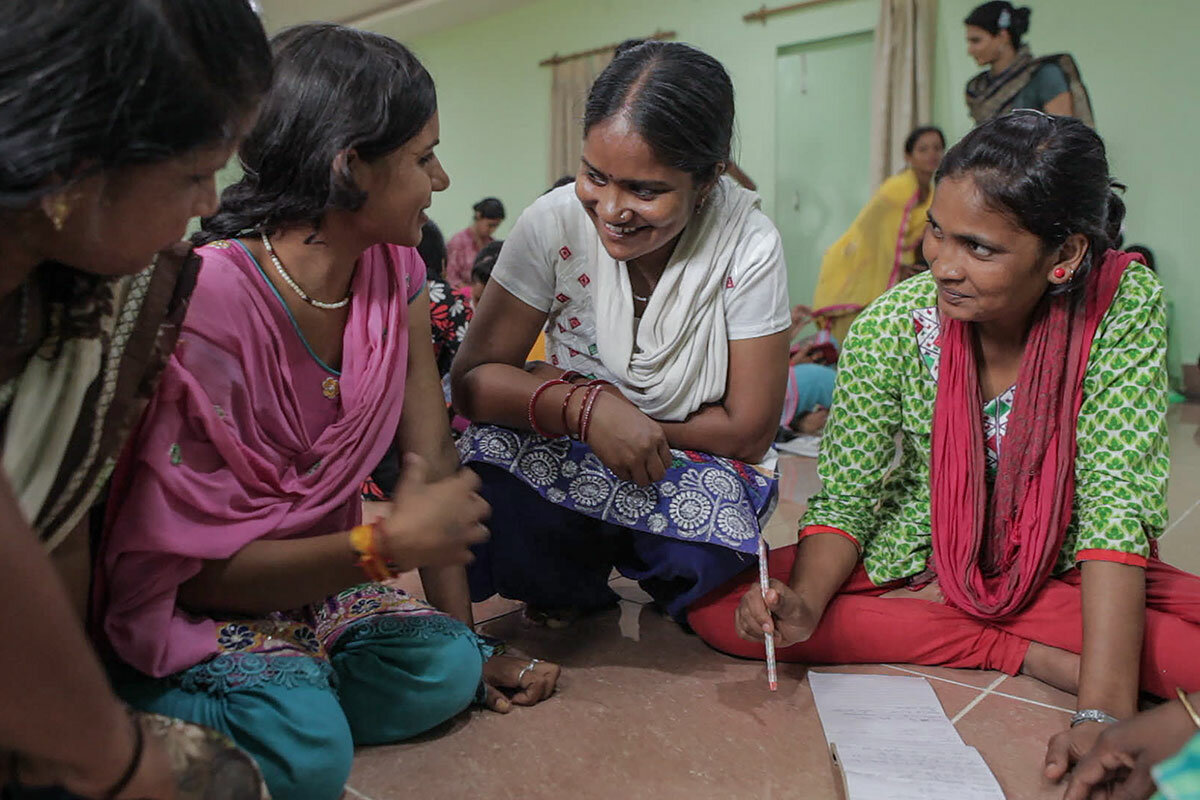
-
By Peter Rainer Contributor
‘Writing With Fire’ captures resolve of female journalists in India
Many movies have dramatized the inner workings of journalism, but in terms of its subject matter, I’ve never seen one quite like the Oscar-nominated documentary “Writing With Fire.” It’s about the reporters of Khabar Lahariya, (English translation: Waves of News), which began as a weekly newspaper in 2002 in Uttar Pradesh, India’s most populous state. The paper is entirely produced, edited, and distributed by Dalit women, the lowest caste in India, and the film demonstrates, with remarkable facility and cunning, how even in the most straitened of circumstances, the press can still hold society accountable.
Co-directed by the husband-and-wife team of Sushmit Ghosh and Rintu Thomas, and shot over approximately four years beginning in 2016, the film focuses on three women: chief reporter Meera Devi, who becomes bureau chief; the wily and seemingly fearless journalist Suneeta Prajapati; and Shyamkali Devi, a newbie who, in the course of the film, comes into her own.
We first encounter the staff of some 30 women at a time when the paper is making the difficult transition to a digital format. Many of the women have little experience with technology. More than a few don’t own mobile phones, which is how many of their stories are meant to be recorded for outlets like Facebook and YouTube.
Despite these obstacles, the communal fervor in the editorial meetings is palpable. The women’s quest is both political and personal. Meera says that journalism is “the essence of democracy,” but there is also a strong element of self-liberation in her words. In the largely patriarchal Indian society, these Dalit women, many of whom travel only on foot, are doing more than a job: They’ve created a calling for themselves.
They face opposition from all sides. Meera’s grudgingly tolerant husband nevertheless disapproves of her career. We learn that she was a child bride, married at 14, a mother while in high school. Holding advanced degrees in both political science and education, Meera worries that, with all her responsibilities outside the home, her daughter is falling behind in school.
Compelling her to continue is her conviction that reporting can actually change things for the better – by no means a given in the notoriously compromised world of Indian journalism. We first see her interviewing a Dalit woman whose claims of being raped regularly by outsiders in her home have gone uninvestigated by the local police. When Meera confronts the authorities, you can see how unseriously they take her. Their mistake. Thanks to her, a measure of justice is finally served.

Against all odds, justice is attained repeatedly in “Writing With Fire.” Suneeta lives with her parents in a poor village with unsteady electricity. Investigating corruption in the same mines where she once worked as a child laborer, she finds herself ringed by angry miners demanding she leave. Not only does she not back down, but she also manages to ingratiate herself into their confidences. Her exposé becomes national news. Over the course of the film, the paper’s YouTube presence swells to 150 million views.
Other stories, some involving the learning-on-the-job Shyamkali, result in the repair of roadways and irrigation systems, and even challenge violent, far-right Hindu nationalists. In one particularly alarming scene, Meera interviews a seemingly calm religious group leader brandishing a sword. We are reminded that journalists have been murdered in India.
Perhaps most heartening about “Writing With Fire” is how the film doesn’t discount the personal toll on these women. Crusaders though they may be, they voice throughout the film their deep doubts and fears. When Suneeta, who briefly leaves the profession, worries about the shame she might bring to her family, or when she says that “sometimes I think it is a sin being born a woman,” she is speaking for an entire generation of Indian women, and not only those in her caste.
But Suneeta must also recognize that her vital work, along with that of her colleagues, is affirming the hope of a new generation.
Peter Rainer is the Monitor’s film critic. “Writing With Fire” is unrated and is in Hindi with English subtitles. The film is available on streaming platforms and debuts on PBS on March 28. Check local listings for times.

Listen
‘Allowed to speak’: Language revival heals a culture
Ancestral languages capture the cultural identity of a people. That’s why Lingít (Tlingit) language revival efforts in Alaska matter more than ever. This is Episode 5 of the podcast series “Say That Again?”

Of Alaska’s 20 Native languages, only a handful have any advanced speakers left. Some have none at all. The Tlingit Culture Language Literacy program, or TCLL, at Harborview Elementary School in Juneau, is attempting to save one of those languages. This “school within a school” incorporates Lingít (pronounced kling-kit, also written as Tlingit) into lessons that help students learn their ancestral language while also still meeting state education standards.
Jessica Chester, one of the program’s teachers, knows firsthand the difficulty of trying to teach a language with so few fluent speakers. And the history of forced assimilation is still felt deep in the community: Most of the advanced speakers, who tend to be older, were punished as children. And even younger generations have faced incidents of language suppression.
“One of the big things that I tell kids is, ‘Someone in your family was forced to stop speaking Lingít,’” she says. “Everyone has that trauma.”
And yet the push to keep the language alive is a reclamation of what was taken, in itself an act of power and pride. Ms. Chester says, “Teaching [my students] who they are, and that their culture and their identity is beautiful, it’s not something to be ashamed of – is so big.” – Jingnan Peng and Jessica Mendoza, Multimedia reporters/producers
This story is meant to be heard, but we understand that listening is not an option for everyone. You can click here for an episode transcript. Also: This podcast has a newsletter! It’s run by host Jessica Mendoza and funded by the International Center for Journalists. You can click here to subscribe.
Episode 5: Language Lesson
Other headline stories we’re watching
(Get live updates throughout the day.)The Monitor's View
Diversity’s benefits for the high court
- Quick Read
- Deep Read ( 2 Min. )
-
By the Monitor's Editorial Board
Every time a demographic barrier has been broken by a nomination to the U.S. Supreme Court – in ethnicity, race, religion, or gender – praise has collided with doubts. Would a more diverse bench of justices bring better justice?
During this week’s questioning of nominee Ketanji Brown Jackson by the Senate Judiciary Committee, those doubts seemed far fewer than for nominees in the past who broke demographic barriers. This is a step closer to the ideal set forth by the main author of the Constitution. “The genius of liberty,” James Madison wrote, “seems to demand on one side, not only that all power should be derived from the people, but that ... the trust should be placed not in a few, but in a number of hands.”
Are the Constitution and its enforcer, the high court, above identities like race, gender, or religion? Viewed case by case, perhaps not. But over the longer arc of history, the court’s decisions show that American society is lifting up its thinking.
If Judge Jackson is confirmed, she will also be a reminder of the need for justice to be universal in its application to all. A diverse court helps achieve that.
Diversity’s benefits for the high court
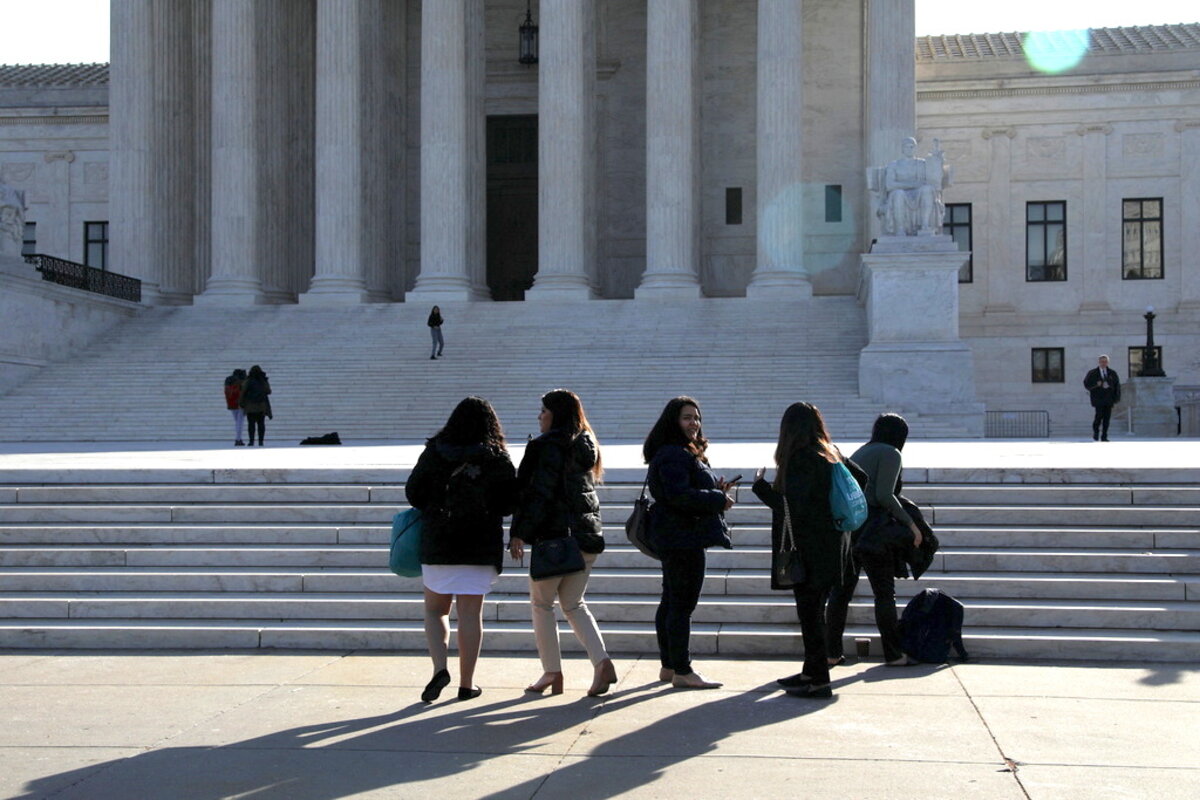
Every time a demographic barrier has been broken by a nomination to the U.S. Supreme Court – in ethnicity, race, religion, or gender – praise has collided with doubts. Would a more diverse bench of justices bring better justice and a more perfect expression of American democracy?
During this week’s questioning of nominee Ketanji Brown Jackson by the Senate Judiciary Committee, those doubts seemed far fewer than for nominees in the past who broke demographic barriers. This is a step closer to the ideal set forth by the main author of the Constitution. “The genius of liberty,” James Madison wrote, “seems to demand on one side, not only that all power should be derived from the people, but that ... the trust should be placed not in a few, but in a number of hands.”
Are the principles of self-governance inherent in the Constitution a natural and eternal unifier of a society riven on issues like race? Are the Constitution and its enforcer, the high court, above identities like race, gender, or religion? Viewed case by case, perhaps not. But over the longer arc of history, the court’s decisions show that American society is lifting up its thinking. In 1896 the court upheld segregation in Plessy v. Ferguson. Fifty-eight years later, its Brown v. Board of Education, it corrected that decision.
One uniquely American tool for bending law toward the country’s founding principles is dissent – and it has been used perhaps most skillfully by the court’s “firsts.” In his 1928 dissent of Olmsted v. United States, Justice Louis Brandeis argued against unlawful wire tapping. The nation’s first Jewish Supreme Court Justice set an enduring standard for privacy when he wrote about the “right to be left alone.” Justices Thurgood Marshall, Ruth Bader Ginsburg, and Antonin Scalia – the first Black man, first Jewish woman, and first Italian American – cast long shadows of influence through their dissents – dissents informed by the diversity of thought shaped by their life experiences.
“We must dissent because America can do better,” Justice Marshall observed, “because America has no choice but to do better.”
If Judge Jackson is confirmed, she will not only be a role model as a Black person and a woman, but will also be a reminder of the need for justice to be universal in its application to all. A diverse court helps achieve that. Each time the range of individual perspectives on the court has widened, the principles entrusted to its care have been renewed.

A Christian Science Perspective
Each weekday, the Monitor includes one clearly labeled religious article offering spiritual insight on contemporary issues, including the news. The publication – in its various forms – is produced for anyone who cares about the progress of the human endeavor around the world and seeks news reported with compassion, intelligence, and an essentially constructive lens. For many, that caring has religious roots. For many, it does not. The Monitor has always embraced both audiences. The Monitor is owned by a church – The First Church of Christ, Scientist, in Boston – whose founder was concerned with both the state of the world and the quality of available news.
Seek out the ‘invisible things’
- Quick Read
- Read or Listen ( 4 Min. )
-
By Karyn Mandan
At times it can seem that when we look at someone, all we see is anger or injustice. But a desire to look deeper and see others as God made them paves the way for healing, harmony, and resolution.
Seek out the ‘invisible things’
The doorbell rings. I open my front door and – surprise – I am facing curly rainbow-colored hair, a red plastic nose, baggy striped pants, and large floppy shoes. Why is a clown at my door? Is it a joke I am not in on – or is it more sinister?
Then, something familiar catches my attention: the joy expressed in the clown’s eyes. It’s my good friend Leslie! (Leslie often performs as a clown for kids’ parties and she is on her way to a party in my neighborhood.)
Laughing, I throw my arms around her and welcome her inside for a good chat. Only by looking beyond the distraction of a painted face and big red nose to focus on Leslie’s eyes am I able to talk naturally, friend to friend and heart to heart. Despite the costume, I know who Leslie is!
Have you ever found yourself reacting uncomfortably to someone else’s appearance or behavior? My clown experience humorously hints at the importance of looking beyond distracting appearances and seeing instead a person’s deeper identity.
Sometimes the distressing appearance is a lot more serious than finding a clown at your door. One day at work, a big mistake happened in our department with serious implications. Immediately one of my colleagues pointed a finger at me in blame. But I’d done nothing wrong. And I knew I was blameless.
In that moment, I had a choice. I could focus on the picture of blame, be thrown back on my heels by the accusation leveled at me, and succumb to fear and defensiveness. Or I could consider something not so obvious – the genuine spiritual nature of the person before me.
What came to me was an intuition (which defied appearances!) whispering, “This woman is as precious and perfect as her divine creator.”
In a letter in the Bible, St. Paul wrote to his companions when they ran into hard times, and he contrasted looking at the “visible things” and the “invisible things.” Even in trying situations, Paul encourages looking on the inside and leaning on God’s grace. He wrote, “These little troubles (which are really so transitory) are winning for us a permanent, glorious and solid reward out of all proportion to our pain. For we are looking all the time not at the visible things but at the invisible. The visible things are transitory: it is the invisible things that are really permanent” (II Corinthians 4:17, 18, J. B. Phillips, The New Testament in Modern English).
To me the “invisible things” point to the presence and activity of God, who is wholly good, at work in everyone. This goodness isn’t always clear to the physical senses, but it’s the actual motive-power of each of us as God’s children, the full reflection of the Divine. Through our innate spiritual intuition we can discern it in one another, and radiate clarity and compassion instead of absorbing negativity.
Quoting St. Paul, Mary Baker Eddy, the discoverer of Christian Science, wrote, “When the divine precepts are understood, they unfold the foundation of fellowship, in which one mind is not at war with another, but all have one Spirit, God, one intelligent source, in accordance with the Scriptural command: ‘Let this Mind be in you, which was also in Christ Jesus’” (“Science and Health with Key to the Scriptures,” p. 276).
Remembering the lesson I learned about the clown outfit masking my dear friend Leslie, now I wanted to see beyond the finger and blame pointed at me. And to engage with the goodness, usefulness, insight, and wisdom that God is always expressing through all of us, including my colleague and me.
This heartfelt desire came out of a moment of prayerful listening and yielding to a clearer perspective, silencing the urge to judge or condemn my colleague. It was about remaining faithful to the inspired view God was showing me about both of us – that our true selfhood is not a mixture of good and bad but entirely spiritual, reflecting the total goodness of God. Glimpsing this truth washed away my defensiveness and awakened in me a kindly feeling.
During that quiet moment of prayer, my colleague’s face softened. We quickly found a constructive solution to the problem. And during the rest of our time working together, I came to value much more her devotion to a worthy cause and disciplined effort to see every project through to completion.
As distracting, and sometimes hurtful and unjust, as someone’s behavior may be, we have the capacity to see their true, spiritual self. When we do, we find ourselves and others “winning ... a permanent, glorious and solid reward.”
The New Testament in Modern English by J.B. Phillips copyright © 1960, 1972 J.B. Phillips. Administered by The Archbishops’ Council of the Church of England. Used by permission.
For a regularly updated collection of insights relating to the war in Ukraine from the Christian Science Perspective column, click here.

A message of love
Seeking peace

A look ahead
Thank you for joining us. Please come again Monday, when we tell the story of a Ukrainian refugee family in Israel amid ongoing debate over who should get to live in the country.




